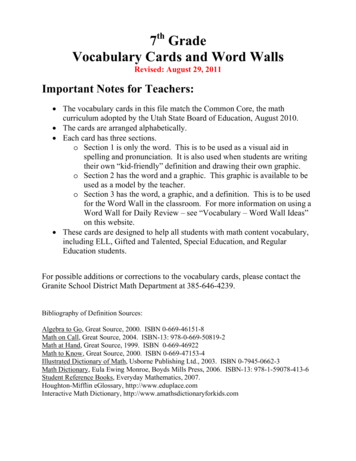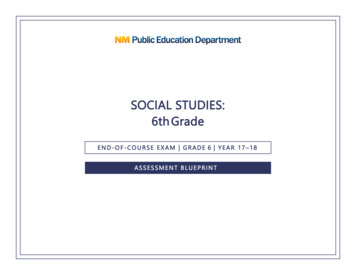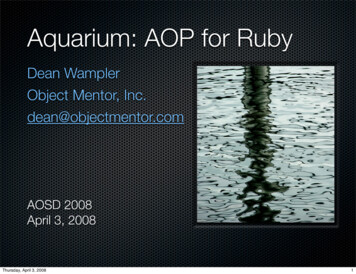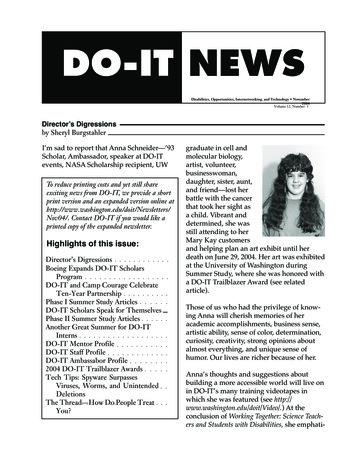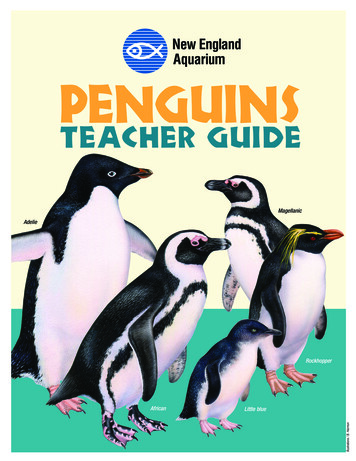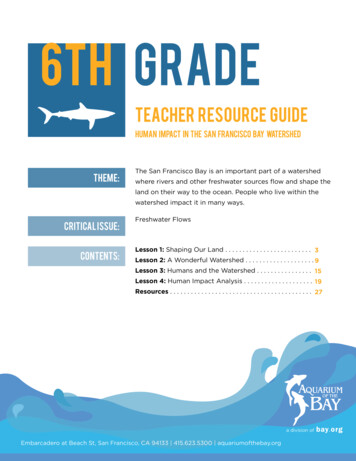
Transcription
6th GradeTeacher Resource GuideHuman Impact in the San Francisco Bay WatershedTheme:The San Francisco Bay is an important part of a watershedwhere rivers and other freshwater sources flow and shape theland on their way to the ocean. People who live within thewatershed impact it in many ways.Critical Issue:Contents:Freshwater FlowsLesson 1: Shaping Our Land . . . . . . . . . . . . . . . . . . . . . . . . . 3Lesson 2: A Wonderful Watershed . . . . . . . . . . . . . . . . . . . . 9Lesson 3: Humans and the Watershed . . . . . . . . . . . . . . . . 15Lesson 4: Human Impact Analysis . . . . . . . . . . . . . . . . . . . . 19Resources . . . . . . . . . . . . . . . . . . . . . . . . . . . . . . . . . . . . . . . . . 27a division ofEmbarcadero at Beach St, San Francisco, CA 94133 415.623.5300 aquariumofthebay.org1
summary:The San Francisco Bay is an important part of a watershed where riversand other freshwater sources flow and shape the land on their way tothe ocean. People who live within the watershed impact it in many ways,including diverting water for drinking, building hydroelectric power plants,and using land for agriculture. Analyzing the costs and benefits of theseimpacts helps people make responsible choices that minimize the negativeimpacts they have on Earth.In this resource guide you will find four lesson plans linked by the commontheme of the natural processes of the San Francisco Bay Watershed andthe impacts humans have on this environment. While the lessons may beused separately or together, the final two (Humans and the Watershedand Human Impact Analysis) can be used as a mini project for students toanalyze the costs and benefits of changing our environment.mission statement:Aquarium of the Bay’s Education and Conservation Department’s missionis to promote literacy in ocean and watershed health, climate changeissues, and science career development through the lens of critical issuessuch as sustainable seafood, marine protected areas, marine debris andplastics, climate change and fresh water flows.acknowledgements:Aquarium of the Bay thanks the S.D. Bechtel, Jr. Foundation for theirgenerous support for our K-12 programs and development of this TeacherResource Guide.2
shaping our landlesson 1Materials Paint trays (one pergroup) Sand/soil (about 1/2 lb.for each tray) Cups (two per group) orspray bottles Water 2-ft. piece of aluminumfoil (one per group) Wide wooden sticks(one per group) (Plantlabels, popsicle sticks, ortongue depressors wouldwork.)Enduring Understanding: The San Francisco Bay is animportant part of a watershed where water shapes thelandscape. A watershed connects all the organismsthat live within it. The health of the watersheddepends on the actions of humans living there.Setup:1.Assemble the following for each group: 1 paint tray 1 piece of aluminum foil Sand/soil Cup of water 1 wooden stick2. Students can put together the trays. Crinkle and fold aluminum foil to form “mountains”along upper edge of the paint tray. Add sand or soil so the trays look like this:3
program outline:Introduction Students observe a photograph of the San Joaquin River. They should notice the shape and colorand what is surrounding the river. This picture shows the river with a very low flow. The reason thispart of the San Joaquin River is low is because much of the water has been diverted for drinking.Explore Students use the materials to create a model of a river. Students should have limited directions sothat they have space to explore what happens and try different scenarios with their model.- Students receive the materials (tray, foil, sand, and water in cups) and are told that they’ll makea model of a river to see how it is formed, how it changes in different situations, and how peoplechange rivers with dams.o Dams are barriers built in rivers to hold back water and control the release of water togenerate electricity.- Have students set up the tray with mountains, a sloping area of land, and a bay.- Make it “rain” in the mountains and observe the river. Students pour water in the mountains andthen draw and describe what happens.o Also direct students to see what happens when the placement or amount of rain is changed.They can record what happens when there is a heavy rainstorm or it rains on top of a river. Letstudents experiment with different scenarios and record all their data on the student handout.- Students also build a “dam” and observe how runoff is affected by human activity.4
program outline continued:oSpecifically observe the water that has traveled to the mouth of the river (at the “bay”).Students discuss their observations with their group and determine how natural and humanprocesses affect water flow. They will answer the questions on their papers, which can beused as notes for a larger class discussion on what situations they tried and what happened.Group discussion and notes Erosion is a process where natural forces move rocks and soil from one place to another. Oneimportant cause of erosion that helps shape Earth’s surface is runoff.Runoff is water moving over the surface of the earth. Runoff is affected by the- amount of rain- amount of vegetation- type of soil- shape of the land- how people use the landRunoff moves downhill due to gravity and forms rills, small grooves in the soil.- Rills flow together to form gullies, which are often only full after it rains, and are made largerthrough erosion.- Gullies flow together to form streams, which are continuously flowing down a slope. A stream orriver flows continuously from the mountains to the ocean.- Rivers are constantly changing and shaping the land around them through erosion and deposition.Deposition happens when soil that is carried by the river settles to the bottom.Shaping Our Land: RunoffRainRill: small groovesin the soil whererunoff flowsffnoruGully: many rillsflowing together;full after it rainsStream: many gulliesflowing togethercontinuouslyFlow of waterdue to: gravityRiver: large streamErosion: Natural process that moves rocks and soil from oneplace to anotherDeposition: Natural process that happens when soil carriedby water settles to the bottom5
program outline continued:Practice Students can complete the flow chart with a partner or individually as practice or to check forunderstanding.Rain creates runoffRill: small grooves in the soil whererunoff flowsGully: many rills flowing together;full after it rainsStream: many gullies flowingtogether continuouslyConclusion 6Students can share their ideas about why freshwater flowing through a watershed is important andhow to conserve water.- Water flowing and shaping our land is important because people and all the other animals andplants need freshwater to survive and space to live. Because of these needs, it is important for usto protect our freshwater supplies byo keeping pollution out of rivers (placing waste in the proper places, recycling oil, etc.).o maintaining the flow of rivers (diverting less water for drinking and agriculture, taking downdams, etc.).- Being aware of human use of rivers (diverting water for drinking, agriculture, building dams togenerate electricity) is important so we can protect our water resources and have them for thefuture.
teacher background:The land around us is constantly changing due to Earth’s natural processes, as well as human actions.One important process that shapes our landscape is the movement of sediment through erosion anddeposition. Water is an essential and dynamic part of creating habitats for plants, animals, and humans.People depend on water not just for basic needs like drinking or farming but also for generatingelectricity, transportation, and recreation. Because we are so dependent on our water resources, it isimportant to understand the processes that move and shape Earth’s surface. In understanding howwater erodes and deposits materials, we can better protect our resources and use them in a sustainableway so we will have them in the future.Water erosion is an important natural process that shapes Earth’s surface, moves sediment from oneplace to another, and provides habitats for living things. One cause of erosion is runoff, which is waterflowing over Earth’s surface. Water erosion begins with rain. Some rainwater soaks into the ground,evaporates, or is absorbed by plants, but some water flows along the surface of the land (runoff).Runoff flows downhill, due to gravity, and carries loosened soil particles or other materials as it moves.The water flowing over the ground creates tiny channels in the soil called rills. The rills continue to flowand converge into larger gullies. Gullies are generally only full of water after a rainstorm. Gullies widendue to erosion and come together to form larger channels called streams. A stream is differentiatedfrom a gully not only because of its size but also because it is continuously flowing down a slope. Astream is rarely dry due to natural processes. A river is a large stream.As streams and rivers flow through an area, they change the land around them. The energy in themoving water chips and grinds the rocks and sediment surrounding the water, creating wider anddeeper channels. The process of water erosion creates valleys, waterfalls, floodplains, lakes, and othershapes in the land. These geographical features create important habitats for plants and animals, as wellas humans.Runoff is affected by many different factors, including the amount of rainfall, amount and types ofvegetation, type of soil, shape of the land, and the ways in which people use the land. For example,deserts with low rainfall will still have a lot of runoff because there is little vegetation to stop it. Also,when people build on top of soil, water cannot soak into the soil, and surface runoff is increased.This can increase the chances of flooding in certain areas. The runoff from urban areas can containpollutants that may be harmful to areas downstream.Humans also have an impact on the process of water erosionand the formation of streams and rivers. Humans are constantlymodifying the world around them to meet their needs. All theactions we take have an effect on the living and non-livingthings around us, even if we don’t realize it. We can help protectthese habitats and ensure that we have the resources we wantfor the future. Conserving water is an important action that wecan all take to protect our rivers and all the living things that relyon freshwater. Helping to reverse negative human impacts, suchas dams and water diversion, can help rivers continue to take theirnatural course.7
glossary:Deposition: Process of sediment created by weathering and erosion being laid down in a new place,changing the shape of Earth’s surfaceErosion: Process whereby natural forces move rocks and soil from one place to anotherGully: Large channel in soil that carries runoff after it rains; created by the convergence of manysmaller rillsRill: Small channel in soil that is created by runoffRiver: Large stream of continuously flowing waterRunoff: Water moving over the surface of the earthStream: Small bodies of water that are continuously flowing down a slope; created by theconvergence of many smaller gullies6th grade standards:California Science Content Standards 2.a. Students know water running downhill is the dominant process in shaping the landscape,including California’s landscape. 2.b. Students know rivers and streams are dynamic systems that erode, transport sediment, changecourse, and flood their banks in natural and recurring patterns.California Next Generation Science Standards MS-ESS2.C. The Roles of Water in Earth’s Surface Processes- MS-ESS2-4. Water continually cycles among land, ocean, and atmosphere via transpiration,evaporation, condensation and crystallization, and precipitation, as well as downhill flows on land.Science and Engineering Practices MS-ESS2-6. Develop and use a model to describe phenomena.California Common Core StandardsELA/Literacy WHST.6-8.2. Write informative/explanatory texts to examine a topic and convey ideas, concepts,and information through the selection, organization, and analysis of relevant information.Mathematics MP.2. Reason abstractly and quantitatively.8
Name:Date:shaping our landObservationsDIRECTIONS: Observe and describe the following picture. Be as descriptive as possible.Exploring the River Part IDIRECTIONS: Use the foil to create mountains at the top of your tray. Make it “rain” on the mountains bypouring water slowly over them. In this box, create a model of your river and then describe it in words.9
Name:Date:exploring the river part IITry different situations (more rain, rainingBuild a dam to block the flow of your river. Makedownstream—be creative!) Record your data below.it rain again in the mountains and observe whathappens to your river.Answer the following questions about your river model:1. What happened when it rained in the mountains? Cite evidence from your model.2. How did the water change the land in your model?3. Observe the water that has formed a lake at the bottom of the tray. How is this water similar to anddifferent from when it came down as rain in the mountains?4. What happened when people built a dam blocking your river? Cite evidence from your model.5. Why do you think rivers are important to the environment?10
11Deposition:Erosion:Flow of water due toShaping Our Land: RunoffDate:Name:
Name:Date:exploring the river part IIIDIRECTIONS: Complete the following flow chart with the following words and their definitions.Stream, Rill, GullyRain creates runoffHow Can I Help?1. How did humans affect the rivers?2. Streams and rivers provide important habitats for plants and animals living in and around them. Listat least three actions that you can take to protect rivers and the habitats they provide.1.2.3.12
a wonderful watershedEnduring Understanding: The San Francisco Bay is anlesson 2important part of a watershed where water shapes thelandscape. A watershed connects all the organisms thatlive within it. The health of the watershed depends on theactions of humans living there.Setup:Materials Watershed model- Paint tray- Aluminum foilmountains- Sand Cups Wateror pictures (seeStudent Materials) “The San FranciscoBay Delta Watershed”text “WatershedConnections” gamecards Paper (one color forevent cards and onecolor for organismcards)1.Set up one watershed model, if you’re using it. Crumplealuminum foil near the top of the paint tray to form mountains;place sand about an inch deep along the inclined portion ofthe paint tray.2. Make copies of “The San Francisco Bay Delta Watershed” text.3. Copy one set of the “Watershed Connection” game cards (onecolor for event cards and one color for organism cards).program outline:Introduction Demonstrate deposition and what a watershed is.- A watershed is the entire area where all the water flowsinto one location. This includes precipitation, surface, andgroundwater. This can be done using the foil and sand modelcreated in Lesson 1 or using the images shown in the StudentMaterials.Students will be asked to observe the color and consistencyof the water in the “bay” and compare it to the water that wasused to make the rain in the mountains (clean tap water). Theentire model represents a watershed, and the water in thebay will have sediment that has been transported through the13
program outline continued:watershed and then settled to the bottom.- This can lead to a discussion of water transporting materials that have been eroded, with specificexamples of the San Francisco Bay Watershed and its features.- The San Francisco Bay Watershed includes almost half of California and includes mountains,valleys, the San Joaquin and Sacramento Rivers, the Sacramento San Joaquin River Delta, and theSan Francisco Bay.o A delta is a landform where one or two rivers flow into a body of water. It is formed by thedeposition of sediment carried by the river as it flows out of the mouth of the river.Rain WaterBayMountains- When rivers flow downhill, they carry sediment with them and lay it down in another place. This iscalled deposition.- A lot of deposition happens in the Sacramento-San Joaquin River Delta, where the water slowsdown and sediment settles out of the water.o The San Francisco Bay gets sediment from rivers flowing into it, which brings in nutrientsand makes it a sandy bottom habitat. Because the San Francisco Bay is also open to theocean, saltwater comes into the bay and mixes with the freshwater from rivers. This mix offreshwater and saltwater is called brackish water. It is what makes the San Francisco Bay anestuary.Have students read “The San Francisco Bay Delta Watershed” text as a wholegroup, in partners, or individually. Students will continue to explore the features of the watershed and why it is an important concept.Interconnected Game: Students will continue to explore the importance ofwatersheds. 14A watershed is important because- it provides freshwater and habitats for living organisms.- it connects all living and non-living things in the watershed. Any actions taken within thewatershed affect the rest of the watershed.Students stand in two concentric circles, facing each other. This can also be done in lines or in
program outline continued: smaller groups, but students need at least three different partners during the course of the game.Students in the outer circle have event cards. Students in the inner circle have organism cards. Thegoal is to work with a partner to determine how the action/event affects that organism.- After a set amount of time, students rotate to the left until told to stop so they have a new partner(time this with music, a stopwatch, a certain number of students, etc.).- Continue changing partners and determining the interconnected nature of everything in awatershed!Discussion of how both human and natural events affect the entire system inwhich the events occur. How do humans specifically affect the watershed? How do the non-living processes (like freshwaterflows) affect the living organisms in the watershed? What actions should we take to make sure thewatershed stays healthy for everyone?Natural events, such as storms or floods, change the physical habitat and resources available for theorganisms living there.Humans can impact the watershed positively by restoring habitats or conserving water, or negativelyby building dams, diverting water, polluting, etc.Every action, whether natural or caused by humans, has an impact on the rest of the watershed.Everything is interdependent.As informed, responsible people, we need to restore habitats, conserve water, and work to preventhabitat destruction and pollution. If we are responsible citizens, we will have the resources we needfor the future!15
teacher background:The Importance of WatershedsA watershed is important because it connects all the living things within it. A watershed is all the landwhere the water from precipitation, surface water, and groundwater flows into one location. Because allthe water flowing within a watershed ends up in one place, the condition of the ending body of wateris dependent on the condition of the rest of the watershed. Debris, plastics, or pollutants that enter thefreshwater flow through surface or groundwater become a hazard for all the ecosystems downstream,and they are even more concentrated at the terminal point.Humans use freshwater for a variety of needs and processes, and they all have a larger effect onthe watershed. We need freshwater to survive, and humans have historically used water as a veryimportant natural resource. Water is diverted for drinking, landscaping, and agriculture. Rivers aredammed to generate electricity. Humans use freshwater for transportation, recreation, and in theproduction of goods. Flowing water is a dynamic system, and humans introduce even more change tothe environment. The effects of our actions are not always immediately apparent, but it is important tounderstand the watershed as an interdependent system of living and non-living things that is constantlychanging.The San Francisco Bay Delta WatershedThe San Francisco Bay Delta Watershed is a largewatershed, spanning more than 40 percent of thearea of California. The two major rivers in the SanFrancisco Bay Delta Watershed are the SacramentoRiver and the San Joaquin River. The San JoaquinRiver is the second longest river in California. It hasbeen greatly affected by human development. TheSan Joaquin River runs near many very importantagricultural areas. Urban runoff, chemical fertilizers,pesticides, and other pollutants have damaged thewater quality of the river. Also, up to 95 percentof the water in the San Joaquin River has beendiverted for uses in cities, as well as for agriculture.The Sacramento River includes some urban andagricultural lands, but the water quality is better thanthat of the San Joaquin River, and there is not asmuch water diverted from it.These two rivers converge before flowing into theSan Francisco Bay. This inland convergence of riversis called an inverted delta. It is an important part ofUS Environmental Protection Agencythe watershed. The Sacramento-San Joaquin RiverDelta provides valuable habitat for many differentanimals and fertile farmland for humans. The Sacramento-San Joaquin River Delta drains into the SanFrancisco Bay and then out to the Pacific Ocean through the Golden Gate.16
teacher background continued:The San Francisco Bay is an important habitat largely because of the watershed. The freshwaterflowing down through the rivers meets the ocean water flowing in through the Golden Gate from thePacific Ocean. The water mixes in the bay to create brackish water. These special conditions in theSan Francisco Bay and delta create the largest estuary on the west coast of the Americas. Estuariesare highly productive ecosystems. The San Francisco Bay and delta are home to around 750 speciesof animals. The high productivity of this ecosystem is partly due to the high levels of nutrients thatflow through the rivers. Sediment that is carried by rivers through the watershed is deposited on thesubstrate when the water flow slows down at the delta and the body of water into which it flows. Thiscreates a habitat able to support a high number and diversity of species.17
glossary:Brackish: Water that is a mix of saltwater and freshwaterDelta: Landform built up where one or two rivers flows into a lake or ocean and sediment settles outof the water; shapes of sediment deposits include fan, cuspate, and bird’s foot; The Sacramento-SanJoaquin River Delta has a fan shape, but it is inverted because the Sacramento and San Joaquin riversconverge and then flow into the San Francisco Bay.Estuary: Body of brackish water connected to both the ocean and a freshwater sourceWatershed: Area of land where all the water from precipitation, groundwater, and surface water flowsinto one location6th grade standards:California Science Content Standards 2.a. Students know water running downhill is the dominant process in shaping the landscape,including California’s landscape. 2.b. Students know rivers and streams are dynamic systems that erode, transport sediment, changecourse, and flood their banks in natural and recurring patterns.California Next Generation Science Standards MS-ESS2.C. The Roles of Water in Earth’s Surface Processes- MS-ESS2-4. Water continually cycles among land, ocean, and atmosphere via transpiration,evaporation, condensation and crystallization, and precipitation, as well as downhill flows on land.California Common Core StandardsELA/Literacy WHST.6-8.2. Write informative/explanatory texts to examine a topic and convey ideas, concepts,and information through the selection, organization, and analysis of relevant information. WHST.6-8.9. Draw evidence from informational texts to support analysis, reflection, and research.18
Name:Date:modeling a watershedObserve the following pictures of a watershed model and then answer the questions next to thepictures.1. Describe the water in the cup that is beingpoured over the mountains.2. What happens to the soil as the rivers flowdownhill?3. What is different about the water when it gets tothe bottom (the “bay”)?19
Name:Date:The San Francisco Bay Delta WatershedPeople rely on freshwater for drinking, growing food,transportation, recreation, and making products like books,clothes, or plastic water bottles. Animals and plants needfreshwater to survive. Moving water provides habitats forliving organisms and is constantly changing the landscapewhere we live. Water can do amazing things like createwaterfalls or carry nutrients from one place to another.California has many rivers and streams carrying freshwaterfrom the mountains to the ocean. These rivers connect all theorganisms in their path. They are all part of the watershed.What Is a Watershed?A watershed is an area of land where all the rain, surfacewater, and groundwater flow into one place. The map inFigure 1 shows San Francisco Bay Delta Watershed inCalifornia. This watershed covers more than 40 percent ofCalifornia and flows into the San Francisco Bay. The majorFigure 1: San Francisco Bay Delta Watershedrivers in this watershed are the Sacramento River and the Joaquin River. The flowing water erodes the soil around itand carries sediment downstream. These two rivers cometogether to form the Sacramento-San Joaquin River Delta. A delta forms when rivers flow into a still bodyof water like a lake or the ocean. The sediment that the river carries settles to the bottom and creates alandform. The freshwater from the rivers flows into the San Francisco Bay and mixes with the saltwaterflowing into the Bay from the Pacific Ocean. This mix of freshwater and saltwater creates an estuary, animportant habitat for many animals.The Importance of WatershedsWatersheds have many parts, including mountains, valleys, rivers, lakes, deltas, and bays. The flowing watercontinuously creates many different habitats for plants and animals. The sediment that is carried by riversand deposited in a delta or bay has nutrients, or food, that the animals need to survive. This creates animportant habitat for plants and animals. There are 750 different species that make their home in the SanFrancisco Bay Delta! Salmon is one example of an animal that needs different parts of the watershed tosurvive. Salmon are born in freshwater streams. They migrate into estuaries to develop, and they spend theiradult life in the ocean before returning to their home stream to reproduce.The watershed also connects all the organisms within it. All the plants and animals living in the San FranciscoBay Delta Watershed are affected by changes anywhere in the watershed. This means that any humanactions will affect organisms living in other parts of the watershed. Trash or pollution that gets into streamswill flow through the watershed and out into the bay. Taking water out of the rivers will destroy habitats foranimals living downstream. Positive actions also affect the watershed. Cleaning up and restoring a streamcan give animals a new habitat. Leaving water in a stream will let freshwater get to the bay, bringing nutrientsthat the animals there need to survive. You make choices every day that affect the world around you.20
Name:Date:The San Francisco Bay Delta Watershed continued1. What is a watershed?2. The San Francisco Bay Delta Watershed covers percent of the state of California.3. What is an estuary?4. What makes an estuary a productive habitat that can support many different animals?5. Why are watersheds important? Explain your reasons.21
event cardsThere is a severe drought in California. Onlyhalf the normal amount of rain and snow hasfallen in the mountains.There is a severe rainstorm in Sacramento.Many of the nearby streams and rivers areflooding.Stockton is using water from the San JoaquinRiver for drinking water, landscaping, andagriculture.along the Sacramento River.A volunteer program in Auburn plants nativetrees in their area.All the sixth grade students at a school inFresno decide to only use reusable waterbottles to reduce the amount of plastic in thewatershed.The Friant Dam was built on the San JoaquinA neighborhood in Oakland is only plantingRiver near Fresno. This dam caused 60 milesnative plants in their yards. Native plants needof the river to run dry.less water as grass to survive.There are many large farms in the San JoaquinValley that use fertilizer to help their cropsgrow. As it flows by, the water in the groundpicks up the fertilizer.A family in Pleasanton washes their car in thedriveway. All the soapy water is rinsed into thestorm drain.Cars in San Jose are leaking oil onto the roadA family in Merced accidentally left theinstead of recycling it properly. It rains thesprinklers on in their yard while they were onnext day.vacation for a week.A sixth grade class in Fremont decides toFarms in the watershed use irrigation to makeorganize a day to clean up Alameda Creek.sure their crops have enough water to survive.People having a picnic in the Sacramento-SanJoaquin River Delta leave their trash on theground.One of the dams in the San Francisco BayDelta Watershed was removed and morewater is flowing through its river.22Logging companies are cutting down treesIn Redwood City, plastic shopping bags left onthe ground are blown away by the wind.Schools in San Francisco are teaching studentshow to conserve water at school and at home.
organism cardsHumansLeopard SharkHumans eat fish and other animals. Theyneed water for drinking, agriculture,making products.This most common shark in SanFrancisco Bay eats clams, crabs, andworms that live in the sand.River OttersBat RaysThese mammals eat fish, crayfish, andbird eggs. They need clean water to huntand survive.These fish live in the San Fran
- Gullies flow together to form streams, which are continuously flowing down a slope. A stream or river flows continuously from the mountains to the ocean. - Rivers are constantly changing and shaping the land around them through erosion and deposition. Deposition happens when soil that is carried by the river settles to the bottom.



